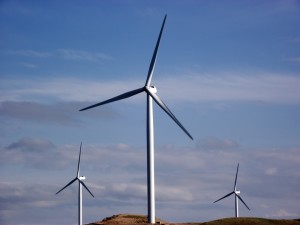In Colorado alone, there are 23 industrial wind farms that are operational, with over 1,800 turbines in over 10 counties. Wind energy has gone from supplying one percent of Colorado’s total energy output in 2005 to 14 percent in 2014. Yet, with the explosion in wind generation, there is a dearth of studies regarding the long-term health impact of industrial wind in Colorado.

And there doesn’t seem to be much interest in cataloging those impacts anytime soon.
The World Health Organization recognized in a 2009 study that 40-55 decibels during sleep cycles can cause “Adverse health effects …” and that children, the chronically ill, and the elderly, “are more severely affected.” The study also found that persistent sound levels above 55 decibels at night can cause an increase the risk of cardio vascular disease.
According to Renewable Northwest, a renewable energy nonprofit organization, the average wind turbine operates at around 50 decibels. However, a 2003 study indicates the during nighttime hours, the sound produced from wind turbines could be 18 decibels higher than the predicted daytime levels due to the lack of ambient background noise. This translates to the average wind turbine being 13 decibels higher than the amount that causes adverse health effects. The study was conducted of wind turbines that were 300 feet tall and found that the problem would be even worse for wind turbines taller than this.
At 328 feet, the average height of U.S. commercial wind turbines exceeds the 300-foot threshold as do the wind turbines in the Golden-West industrial wind project just east of Colorado Springs. Turbines at the proposed Rush Creek Wind Project in eastern Colorado could be even taller.
Researchers found that wind turbines also produce infrasound, frequencies under 20 hertz, as well. Long-term exposure to infrasound can also cause sleep disturbance and other issues of wellness. As found in a 2015 compilation of studies, exposure to infrasound can cause “… chronic sleep disturbance, dizziness, tinnitus, heart palpitations, vibrations and pressure sensations in the head and chest …”
The International Organization for Standardization (ISO), an independent, nongovernmental organization and the world’s largest developer and publisher of international standards says vibrations between 1 hertz and .1 hertz can cause motion sickness (as cited in ISO Standard 9996:2000). These are the same frequency levels produced by the Golden-West wind farm, according to a field study conducted by Robert Rand, an independent acoustic consultant out of Boulder, Colo. These are also the same symptoms experienced by some of the residents that live nearby.
Most of studies only examine short-term exposure to industrial wind farms. A report published in the Bulletin of Science, Technology & Society shows, “… no studies were found which come close to replicating the long-term exposures to low level infrasound experienced by those living near wind turbines.”
Both Cindy Cobb and Sandra Wolfe from Calhan, Colo., live in the shadow of Golden-West, and blame the turbines for deteriorating health. They report dizziness, nausea, loss of sleep and headaches. They say their symptoms coincide with when the wind farm became operational in September 2015.
![]() Cobb adds lethargy and high blood pressure to the list of symptoms, and she fears for life, “I am here almost 24/7, 365 days. I have no break, and [I] fear living here is going to kill me.”
Cobb adds lethargy and high blood pressure to the list of symptoms, and she fears for life, “I am here almost 24/7, 365 days. I have no break, and [I] fear living here is going to kill me.”
According to Wolfe, the relentless spinning causes stress and loss of sleep. She has resorted to sleeping off-site from her own property.
People in Maine, Ontario and New Zealand have reported similar symptoms in connection to nearby wind farms.
How do we know if industrial wind is the cause of their deteriorating health? We won’t until there is more thorough study of the health impacts of wind turbines and where they are sited. With the state’s largest electricity provider Xcel Energy also being the nation’s leading provider of industrial wind, everyone would be well served if Colorado led the way on the study of health impacts of commercial scale wind projects.
In the meantime, there are things the state could do to mitigate any potential impact.
Regulators could adapt the British Noise Association and the French Academy of Medicine’s siting recommendations of 1.5 km, or 1 mile, setbacks for wind farms to be built next to residential areas. The minimum distance for Calhan residents is 1320 feet. This is a quarter of the recommended distance. Turbines within the 1-mile distance should be stopped until studies are complete.
Another option is for pending industrial projects like Rush Creek in eastern Colorado to consider installing smaller turbines. Existing science suggests that larger turbines and denser wind farms compound the problems of infrasound and audible sound. Wind turbines in Denmark, the Vestas V17, are only 72 feet tall, while the Calhan wind farm uses turbines that are 315 feet tall, more than 4 times taller. By decreasing the height and the blade size of wind turbines or increasing distance from rural/residential areas, wind farms can help fight the possible effects of audible sound and infrasound.
Colorado and the United States aren’t Europe, and our own long-term health impact studies could yield alternative recommendations. Without additional study, we won’t know. Until then, for those living in the shadow of industrial wind farms, it’s like being in the dark.
Kohl Watson is an energy researcher with the Future Leaders Program at the Independence Institute, a free-market think tank in Denver.


